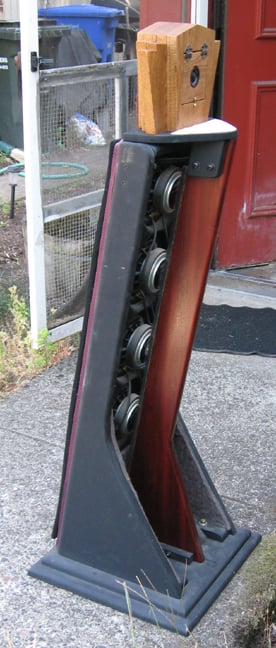Your Legal Resource
My Open-baffle Hi-fi Speaker System, "the Aurium Waveguide"
The Aurium Waveguide speaker system is a tri-amp'd open-baffle (mostly dipole) speaker system, with an active 4 pole Linkwitz-Riley crossover, which has active woofer EQ and open-baffle EQ. It's a satellite/subwoofer arrangement, so the woofers can be positioned independently from the satellite speakers for better interaction with room acoustics. I've also included my variation of the Bob Carver "Holographic Generator" in the crossover chassis (bypassable).
The two sealed woofer cabinets are "monopole". The tweeter is monopole from 1.4kHZ up to about 7kHZ (The 7kHZ can be easily modified). It's my opinion that between roughly 1kHZ and 6kHZ monopolar is likely to give you better stereo imaging effect clarity than dipole since fewer inconsistent room reflections will cause less balance deviation in the critical imaging frequency range. From 100HZ to 1.4kHZ, and from 7kHZ - 25kHZ this speaker system is a dipole.
Inter-aural crosstalk, which exists in virtually all playback systems that use speakers, significantly damages imaging cues below about 1kHZ. This is because inter-aural crosstalk needs to happen only once, or our ear-brain mechanism won't know how to interpret it. In a true stereo recording, this will happen at the recording end. If it happens again at the playback end, our ear-brain mechanism gets confused, and imaging isn't at all what it could be. So it's the frequency range of about 800HZ - 7kHZ where the majority of the stereo imaging magic happens.
There are two ways to minimize this issue (that I know of) in a typical playback system. One is to use an inter-aural cancellation function (Carver or Polk methods), which requires the listener to sit exactly centered between the L and R speakers and back a certain distance, forming some variation of a triangle with the speakers. (and have little or no sidewall reflection issues). Another approach is to have speakers that are "open-baffle" below about 1kHZ, to reintroduce an arguably false sense of depth in the frequency range below 1kHZ, where we sense image location by timing or phase differentials, rather than amplitude differentials. This "false" sense of depth synthesis works fairly well in many rooms, as opposed to the Carver or Polk interaural cancellation methods. For the person who's willing to sit in just the right place, I've developed an inter-aural cancellation circuit similar to the Carver one, that can be engaged, for that extra sense of being there with the musicians. These two methods of bringing back a sense of being there in the lower midrange frequencies can actually work well together, rather than getting in each other's way.
Above about 6kHZ we sense image location differently due to the size of the wavelengths. The shape of our outer ear comes into play and helps us sense height as well. It's my opinion that high treble, above 7 - 12 kHz sounds significantly more "real" when it's emitted out both the front and rear of a speaker, especially if the rear tweeter can be angled upward, so the highest frequencies come from above as well. Comb filter effects from having two tweeters is a non-issue because of the path length differential being so much larger than the wavelengths involved. The comb filter cancellations will be too close together for us to perceive them. This adds "air" to the cymbals and doesn't really damage anything, unless the wall behind the speakers is absorptive on one side and reflective on the other, in which case the rear tweeters can be disabled.
The rear tweeter has its own Banana jacks for the highpass capacitor and/or resistor, so it's fully adjustable in both cut-off frequency and amplitude, depending on what works best in a given room. Like all of my speaker systems, this one is experimental to some degree. I always like to throw in something different, that might flop, that I can learn from. In this case, it's mostly the vertical line array of 100HZ - 1.4kHZ five-inch drivers, which in theory could work better with floor-to-ceiling reflection issues. This lower mid-range wave propagation will be significantly more directional on the vertical axis.
Rear Side View
The Tweeter Tower shelf never quite touches the front baffle board.
The tweeter tower has its own mechanical "return to the ground".
This way, the tweeter output will avoid the vibrational modulation, caused by the 5-inch drivers. Probably a nonissue.
The real reason for the waveguide fin on the backside is to help diffuse the rear waves a bit, so hot spots would be minimized.
